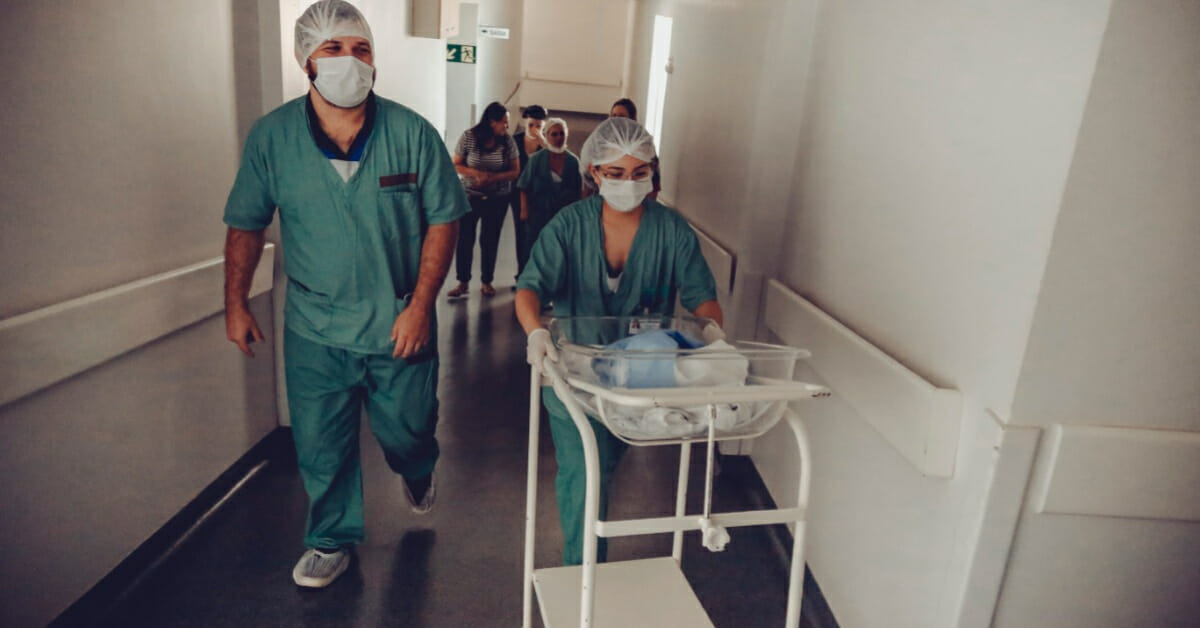What Does A Labor And Delivery Nurse Do?
In short, a labor and delivery nurse is the nurse who assists a patient throughout the labor and delivery process and into the postpartum period. They are responsible for the admission of a pregnant client to the discharge of a Mom and her baby.
Take the Course: Maternity Nursing
Cover all topics around the care of the childbearing family for nursing school with the all-in-one online class.
Assisting during labor
As with any nursing field, a L&D nurse is responsible for comprehensive and holistic patient care. What makes working in the obstetric field different is that one patient becomes two, and both need constant monitoring and care.
Labor and delivery nurses (L&D nurses for short) are responsible for monitoring contractions, labor progress, and mommy and baby’s vitals. During the labor process, a L&D nurse is there to attend to the mother’s needs. They can help with anything from pain management and relaxation techniques to helping with hydration and supporting the birth partner. They really are Jack-of-all-trades.
Providing postpartum care
Since a newborn usually stays with the mother after birth, a L&D nurse is also responsible for caring for the baby and monitoring its vitals. As a L&D nurse, you would be responsible for monitoring the baby, helping with skin-to-skin contact (kangaroo care), keeping the baby warm, and helping the mother navigate the first few moments with her new baby.

Educating patients and partners
L&D nurses play a significant role in patient education. They can provide breastfeeding support, help prevent neonatal hypothermia, teach new parents how to bathe and dress their baby, and provide practical tips on caring for the new baby.
Skills required to be a labor and delivery nurse
If you’re thinking of becoming a labor and delivery nurse, you will need to have the following skills:
- Strong communication
- Caring nature
- Compassion and empathy
- Ability to function in high-stress environments
- Critical thinking
- Ability to establish trust (you’re going to be there in a woman’s most vulnerable moment)
- Ability to work as part of a team
Related videos
Labor and Delivery Nurse vs. Nurse Midwife
Many of the responsibilities of L&D nurses and Midwives overlap, as they both work in the obstetric ward to assist a mother in labor. The difference is that a Nurse Midwife has received more advanced training. Midwives are also allowed to take responsibility for patients during the pre-pregnancy period to assist with reproductive health and to provide routine prenatal checks during pregnancy.
If the doctor does not arrive on time, both an L&D nurse and a midwife could deliver a baby in a hospital setting. In a home birth setting, a midwife would be the one to do the delivery because they are trained as nurse practitioners. This means they may consult a patient independently and plan with the patient for a home delivery.
How to Become a Labor and Delivery Nurse
Because becoming a L&D nurse is a speciality, the training takes a little longer than RN training. First, you must qualify as an RN, pass the NCLEX, and specialize as a L&D nurse. Below, I’ll go over each of these steps in detail.
Educational requirements to become an RN
To become a L&D nurse, you first need to become a nurse. This can be done by either doing an Associate Degree in Nursing (ADN) or a Bachelor of Science in Nursing (BSN) degree. An ADN takes two years to complete, while a BSN takes two to four years, depending on prior experience. ADN is the minimum required degree to continue on to becoming a L&D nurse. While both would allow you to become a L&D nurse, there are more opportunities with the BSN. Because BSN is a higher degree, these nurses have higher earning potential and can further qualify as nurse practitioners.
Pass the NCLEX-RN exam and obtain state licensure
After completing an ADN or a BSN degree, you will need to take the NCLEX-RN exam. How soon you take the NCLEX exam depends on your state. Generally, graduates take the NCLEX about 45 days after graduating from nursing school. If you are taking the NCLEX exam soon, try Lecturio’s NCLEX practice questions.
Once you have passed your NCLEX-RN exam, you can apply to your state licensing board for your license.
Gaining experience
Now that you’re a registered nurse (RN), it’s time to gain some labor and delivery experience. Look for jobs or internships in an obstetric ward. This experience is crucial for developing your skills, making sure this career path is the right fit for you and that you are happy with your career choice. An internship also helps improve your CV and may help you apply for specialized training.
Specialized training
Once you have completed your internship and gained experience in an obstetric ward, you may want to consider specializing as a L&D nurse. Specializing would be beneficial as employers prefer nurses who have speciality training, and specialized nurses have the potential to earn higher salaries.
How long does this take to become a labor and delivery nurse?
Becoming a labor and delivery nurse takes about 2–4 years. The exact timeline depends on your degree. Certification requires an additional 1–2 years of work experience, depending on your state.
How Much Does a Labor and Delivery Nurse Make?
Your salary will probably vary depending on location, level of education, and years of experience. Salaries may differ even more for those who are self-employed or work part-time.
According to the US Bureau of Labor Statistics, the average salary for a Labor and Delivery Nurse ranges from $65,900 to $133,990 per year (with Alabama having the lowest average annual salary and California the highest). Remember that this is highly dependent on many factors. Here, you can see the full breakdown of average salaries by state.
Conclusion
Becoming a labor and delivery nurse may be difficult, but it’s worth it! It can take 4 to 6 years to earn your ADN/BSN, pass the NCLEX, get licensed, complete an internship, and specialize in L&D.
Seeing new life come into the world is an amazing experience few people have. If you’re considering this career, I say, “Go for it!”





